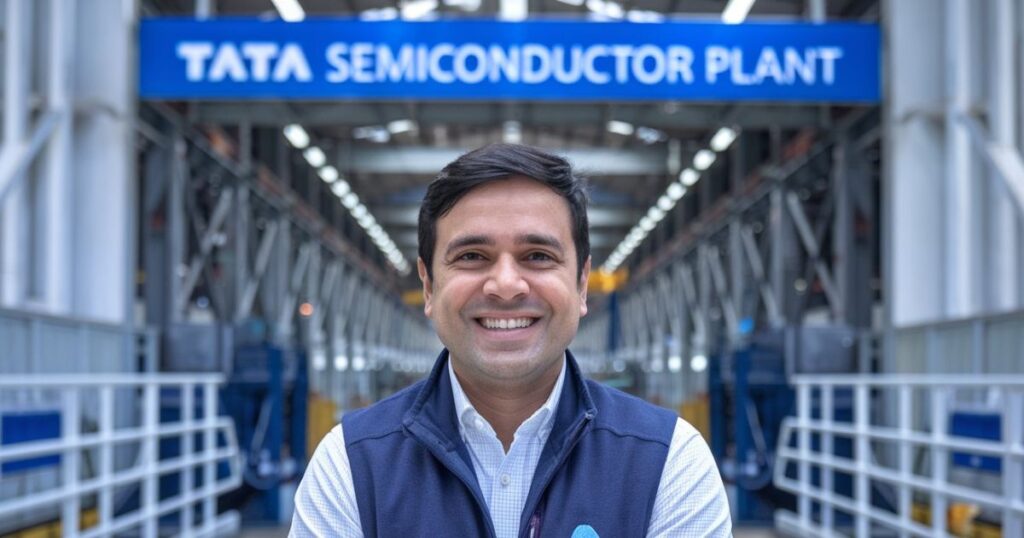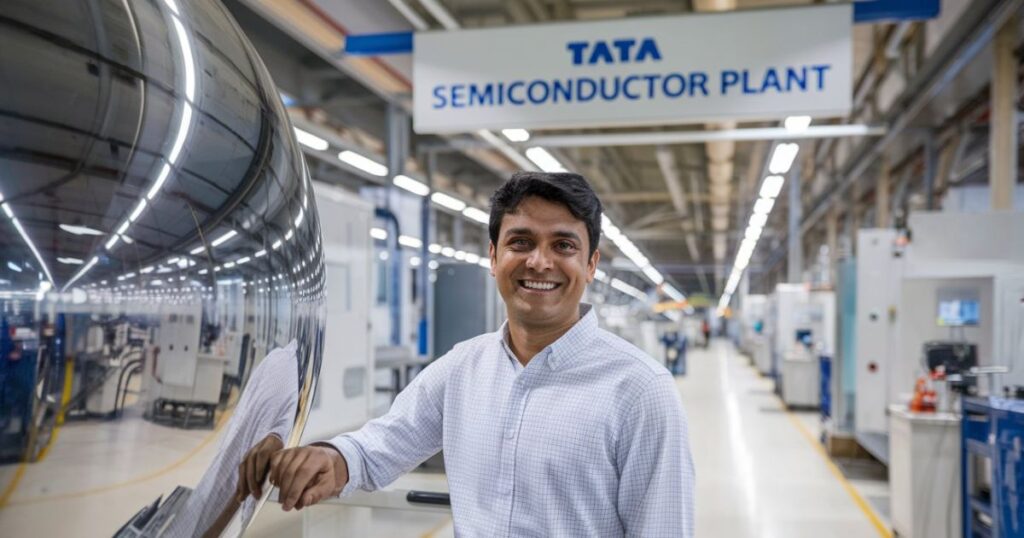Let’s kick things off with a little peek into the semiconductor market. You might not realize it, but semiconductors are the unsung heroes of just about all tech we use today. From smartphones to cars, they’re everywhere.
As of 2023, the global semiconductor market is valued at over $500 billion, driven by rising consumer demand for electronic devices and advancements in artificial intelligence and IoT. It’s like a tech party, and semiconductors are the life of it!
So, why are tata semiconductors such a big deal? Think of them as the brains of modern electronics. They control and manage the flow of electric current and are crucial for running microchips and circuitry. Without them, our world would pretty much grind to a halt. Imagine trying to scroll through social media without your smartphone or binge-watch a series without your smart TV—that’s the power of semiconductors!

Tata Semiconductor Move to Dholera
A. Reasons for Choosing Dholera as a Location
Now, onto tata semiconductor company and their bold move to Dholera! Why Dholera, you ask? For starters, it’s part of Gujarat’s ambitious plan to become a manufacturing powerhouse.
With its proximity to major transportation links and a government that’s not shy about supporting tech initiatives, Dholera seems to be the perfect spot. Plus, the land is relatively affordable, and it boasts plenty of space to grow.
The industry is buzzing with innovation! Every year, we’re seeing smaller, faster, and more efficient chips, thanks to advancements like 5G, AI, and even quantum computing. It’s not just about speed; it’s about making things more energy-efficient and sustainable. Plus, there’s a major push for localizing production, especially after the supply chain hiccups during the pandemic.
B. Tata’s Vision and Goals for the Semiconductor Plant
Tata has big dreams for this semiconductor plant. They’re not just looking to build any ordinary factory; they’re aiming to create a hub of innovation. The goal is to produce high-end semiconductors that can cater to both domestic and international markets.
Imagine the pride in saying, “Yep, this chip was made right here in India!” It’s about putting India on the global map for tech manufacturing.
C. Role of Government Policies in Facilitating the Move
The Indian government has rolled out some impressive policies to attract semiconductor manufacturers. With incentives like tax breaks and support for infrastructure development, it’s clear they’re serious about making India a semiconductor hub.
The more welcoming the policies, the easier it’ll be for Tata to set up shop and make things happen.
Dholera: An Emerging Technology Hub
A. Infrastructure Developments Supporting the Semiconductor Industry
Dholera Sir is not just a quiet town anymore. With major infrastructure investments underway—like roads, power supply, and even advanced internet connectivity—it’s shaping up to be a bustling tech hub.
These developments create favorable conditions for companies looking to set up manufacturing facilities.
B. Economic Impact on the Local Community
The arrival of Tata’s semiconductor plant means good news for the local community, too. It’s expected to generate thousands of jobs—not just at the plant, but also in supporting industries like logistics, hospitality, and retail. Local businesses are also likely to benefit from increased foot traffic. It’s a win-win situation!
C. Comparing Dholera to Other Global Technology Hubs
When you think of tech hubs, places like Silicon Valley or Shenzhen come to mind. Dholera, however, aims to carve its own niche. While it may not have the same reputation—yet—it’s on track to become a key player in the semiconductor game. It’s all about positioning itself as an attractive option for foreign investment and tech talent.
Employment Opportunities and Skill Development
A. Job Creation and Workforce Needs
With the semiconductor plant in the pipeline, job opportunities are set to explode. Tata is expected to hire engineers, technicians, and a whole range of supporting staff. This could mean a significant boost in local employment rates, transforming Dholera’s economic landscape.
B. Training Programs and Collaborations with Educational Institutions
To ensure a steady stream of qualified workers, Tata is likely to engage with local educational institutions. Think of partnerships for specialized training programs focused on semiconductor manufacturing. This way, fresh grads can jump straight into rewarding jobs, equipped with the right skills.

C. Long-Term Career Prospects in the Semiconductor Field
With the semiconductor industry booming, career prospects look bright. Not only will there be jobs available, but skills learned in this field are transferable to other areas of technology. Employees can build solid careers—not just at Tata Semiconductor , but across the tech landscape as India’s industry matures.
Challenges and Opportunities Ahead
A. Potential Challenges in Establishing the Semiconductor Plant
Of course, no story is without its hurdles. Establishing the semiconductor plant isn’t without challenges. Supply chain issues, skilled labor shortages, and potential regulatory bottlenecks could pose threats to smooth operations. But hey, every challenge is just an opportunity in disguise, right?
B. Opportunities for Innovation and Business Growth
If tackled well, these challenges can lead to innovation. Tata could explore new ways to streamline processes or even develop new semiconductor technologies that set them apart from the competition. If they play their cards right, they could end up leading the charge in Indian semiconductor innovation.
C. Strategic Collaborations and Partnerships in the Industry
Forming partnerships could be key for Tata. Collaborating with tech firms, research organizations, or other sectors can facilitate knowledge exchange and spur innovation. Plus, it can help in overcoming challenges by pooling resources and expertise.
Tata Electronics Signs MoU with Tokyo Electron
In a groundbreaking development for India’s growing semiconductor industry, Tata Electronics Limited (TEL) has signed a Memorandum of Understanding (MoU) with Japan-based Tokyo Electron Limited (TEL), a global leader in semiconductor equipment manufacturing. The agreement marks a significant step forward in India’s ambitions to establish itself as a key player in the global semiconductor supply chain.
The Tata Semiconductor project isn’t just about chips; it’s about rewriting India’s tech destiny. With Powerchip PSMC bringing expertise, Dholera is transforming from a quiet town into a buzzing hub of innovation and opportunity.
As the world watches, India Semiconductor strides toward self-reliance, and Dholera Smart City emerges as the beating heart of this transformation—truly, India’s Next Silicon Valley is here.
Strengthening India’s Semiconductor Ecosystem
The MoU entails Tata Electronics purchasing advanced semiconductor manufacturing equipment and services from Tokyo Electron. This partnership underscores Tata Electronics’ commitment to building state-of-the-art facilities and contributing to India’s semiconductor mission, which has received robust backing from the government under the Production Linked Incentive (PLI) scheme.
Key Highlights of the MoU
- Technology Transfer: Tokyo Electron will supply TEL with cutting-edge tools, including wafer fabrication and process optimization equipment, vital for semiconductor production.
- Knowledge Sharing: Both companies will collaborate on training programs and technical workshops to upskill Indian talent in semiconductor manufacturing.
- Strategic Support: The agreement aligns with India’s vision of reducing dependency on semiconductor imports by fostering local production capabilities.
What the Leaders Say
Mr. Natarajan Chandrasekaran, Chairman of Tata Sons, said,
“This collaboration with Tokyo Electron is a testament to Tata Electronics’ vision to lead India’s charge into advanced semiconductor manufacturing. Together, we aim to establish a robust semiconductor ecosystem in India.”
Mr. Toshiki Kawai, CEO of Tokyo Electron, added,
“India has tremendous potential to become a significant player in the semiconductor industry. We are delighted to partner with Tata Electronics to bring our world-class technology and expertise to this rapidly growing market.”
With this MoU, Tata Electronics and Tokyo Electron are set to play pivotal roles in shaping India’s semiconductor landscape. Industry experts believe this partnership will bolster India’s credibility in the global market while laying the foundation for long-term growth in the tech and electronics sectors.
As India continues its journey toward becoming a global tech powerhouse, partnerships like these signal a promising future for the nation’s burgeoning semiconductor industry.
What’s Next for Tata Semiconductor?
As of February 2025, posts on X and industry reports highlight steady progress, with visuals of the Dholera site buzzing with activity. The first phase focuses on 28nm chips, with plans to scale down to 22nm, catering to both domestic and international markets. Meanwhile, Tata’s parallel Rs 27,000 crore assembly and test facility in Assam (set for production by mid-2025) complements the Dholera fab, creating a robust ecosystem. Analysts predict that by 2029, India—led by Dholera—could rank among the top five semiconductor ecosystems worldwide.
VI. Conclusion
A. Summary of Key Points
So, to wrap it all up: Tata Semiconductor is set for an exciting journey in Dholera. With strong government support, promising infrastructure, and a vision for innovation, the future looks bright.
B. Future Outlook for Tata Semiconductor in Dholera
The next few years will be crucial as they establish operations and start hiring. If all goes well, Dholera smart city could genuinely become a significant player in the global semiconductor arena.
C. The Potential of Dholera as India’s Next Silicon Valley
With everything lined up, Dholera is knocking on the door to become India’s very own Silicon Valley. It’s an exciting time to be part of this developing story, and who knows? We might just witness the rise of a new tech giant right here in India.
Frequently Asked Questions (FAQs)
What makes Dholera a suitable location for semiconductor manufacturing?
Dholera boasts excellent transportation links, supportive government policies, and ample land for development, making it an attractive site for semiconductor manufacturing.
What are the expected benefits for local residents?
Local residents can look forward to job opportunities, economic growth, and improved infrastructure. As Tata sets up its plant, the ripple effect will benefit the entire community.
How will Tata Semiconductor impact India’s position in the global market?
Tata Semiconductor has the potential to enhance India’s reputation as a global player in tech manufacturing, positioning it as a go-to destination for semiconductor production and innovation.

1 thought on “Tata Semiconductor in Dholera: India’s Next Silicon Valley is Here”
Comments are closed.